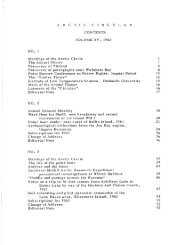Volume 8, 1955 - The Arctic Circle - Home
Volume 8, 1955 - The Arctic Circle - Home
Volume 8, 1955 - The Arctic Circle - Home
- No tags were found...
Create successful ePaper yourself
Turn your PDF publications into a flip-book with our unique Google optimized e-Paper software.
VOL. VIII NO.4THE ARCTIC CIRCULAR71This fortunate discovery of nine archaeological cultures insequence should throw light on a number of crucial problems ofNew World prehistory. <strong>The</strong> earliest complex, called the BritishMountain Complex, is found und·erneath marine gray clays whichwere deposited when the sea level was more than 200 feet higherthan it is at present. Furthermore, faunal remains show thatthese people, besides hunting caribou, also hunted some sort ofgiant buffalo, now extinct. As yet there is no way of dating thisculture exactly, but it must be among the earliest found in NorthAmerica. It is represented by ten artifacts, most of which arechoppers and scrapers so crude that it is impossible to determinetheir cultural relationships.<strong>The</strong> earliest culture layer above the gray clays is theEngigstciak Complex (Eng-ig-stciak -- meaning "young mountain"in Eskimo). <strong>The</strong> projectile points include a number of Angosturapoints, a Plainview point, and a fluted point. <strong>The</strong>re are also anumber of crude end-scrapers, side-scrapers, and bifacial blades.All of these artifacts occur in the Great Flains farther south,where they are from 6,000 to 10,000 years old. <strong>The</strong> northernmaterial is however distinctive in having a few crude burins andprismatic blades associated with it, indicating some sort ofAsiatic connection. Though the data are still incomplete one cannothelp but speculate as to whether this culture complex does notrepresent peoples who have recently moved from Asia, and arebeginning to develop a type of material culture that is typical ofthe early horizons in the North American Great Plains.Above these remains were materials that inCluded a numberof small burins, micro -blades, side blades, and smaller projectilepoints, called the New Mountain Complex. In many waysthis complex is similar to the earliest found in Alaska at CapeDenbigh and the earliest found in the Eastern <strong>Arctic</strong>, calledSarqaq, which may well be an ancestor to Dorset. Associatedwith the New Mountain Complex are elk (wapiti), buffalo, andmuskox, indicating that the climate along the Firth River wasperhaps more pleasant than it is today. <strong>The</strong>se New Mountainremains also suggest a movement out of northeastern Siberia, inthis case of Early Neolithic or Mesolithic peoples, who ultimatelyspread across the New World <strong>Arctic</strong> as far east as Greenlandduring the postglacial optimum.Following these earlier cultures are three complexeswhich include pottery along with a very few burins and micro-blades,












